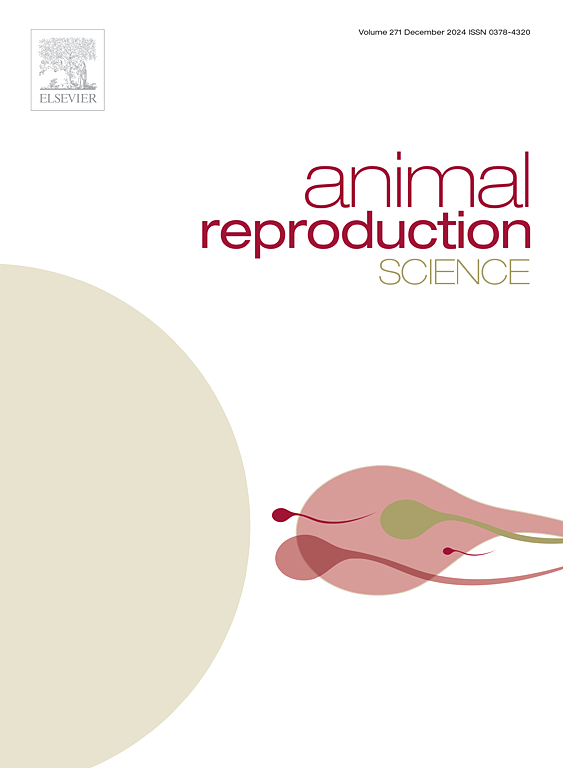Effects of mitoquinone and caffeic acid on spermatological parameters and OGG1/ROMO1 gene expression of post-thawed ram semen
IF 2.2
2区 农林科学
Q1 AGRICULTURE, DAIRY & ANIMAL SCIENCE
引用次数: 0
Abstract
The aim of this study was to determine the freezability of ram semen with extenders containing mitoquinone or caffeic acid. Collected ram semen samples were pooled and divided into seven equal aliquots. Each aliquot was diluted with Tris-based extender according to control and antioxidant groups (Control, Mitoquinone (MitoQ) 100 nM, 150 nM, 200 nM; Caffeic Acid (CA) 50 µM, 100 µM, 150 µM). The post-thaw spermatological, antioxidant parameters and OGG1/ROMO1 gene expression and methylation were evaluated. It was determined that the CASA post-thaw motility of MitoQ200, CA100 and CA150 antioxidant groups were statistically higher than the control group (P < 0.05). The post-thaw plasma membrane integrity of MitoQ groups was compared with CA groups, CA100 group, which had the lowest plasma membrane integrity among the antioxidant groups. The post-thaw acrosome membrane damage of all the antioxidant groups were statistically lower than control group, except CA50 and CA100 groups (P < 0.05). For the post-thaw mitochondrial membrane potential, all groups except the CA50 group were determined to be superior to the control group (P < 0.05). No statistical difference was observed among all groups including control group in terms of post-thaw DNA fragmentation, MDA and TAC values. MitoQ significantly altered the expression of the OGG1 genes, an effect mediated through DNA methylation (P < 0.05). Furthermore, caffeic acid altered the ROMO1 gene expression (P < 0.05). Based on the spermatological parameters and gene expression and methylation levels obtained in the current study, it was determined that mitoquinone 200 nM and caffeic acid 150 µM doses had a positive effect on the freezability of ram semen.
mito醌和咖啡酸对解冻后公羊精液精子学参数和OGG1/ROMO1基因表达的影响
本研究的目的是用含有mitoquinone或咖啡酸的填充剂测定公羊精液的冷冻性。收集的公羊精液样本被分成7等份。按对照组和抗氧化组分别用tris扩展剂稀释每个同品(对照组,mito醌(MitoQ) 100 nM, 150 nM, 200 nM;咖啡酸(CA) 50 µM, 100 µM, 150 µM)。评估解冻后精子学、抗氧化参数及OGG1/ROMO1基因表达和甲基化。结果表明,MitoQ200、CA100、CA150抗氧化组解冻后CASA活力显著高于对照组(P <; 0.05)。与CA组、CA100组相比,MitoQ组解冻后的质膜完整性最低。除CA50、CA100组外,各抗氧化组解冻后顶体膜损伤均显著低于对照组(P <; 0.05)。解冻后线粒体膜电位除CA50组外,其余各组均优于对照组(P <; 0.05)。包括对照组在内的各组解冻后DNA片段化、MDA和TAC值均无统计学差异。MitoQ通过DNA甲基化介导显著改变了OGG1基因的表达(P <; 0.05)。此外,咖啡酸改变了ROMO1基因的表达(P <; 0.05)。根据本研究获得的精子学参数和基因表达及甲基化水平,确定200 nM剂量的mitoquinone和150 µM剂量的咖啡酸对公羊精液的冷冻性有积极影响。
本文章由计算机程序翻译,如有差异,请以英文原文为准。
求助全文
约1分钟内获得全文
求助全文
来源期刊

Animal Reproduction Science
农林科学-奶制品与动物科学
CiteScore
4.50
自引率
9.10%
发文量
136
审稿时长
54 days
期刊介绍:
Animal Reproduction Science publishes results from studies relating to reproduction and fertility in animals. This includes both fundamental research and applied studies, including management practices that increase our understanding of the biology and manipulation of reproduction. Manuscripts should go into depth in the mechanisms involved in the research reported, rather than a give a mere description of findings. The focus is on animals that are useful to humans including food- and fibre-producing; companion/recreational; captive; and endangered species including zoo animals, but excluding laboratory animals unless the results of the study provide new information that impacts the basic understanding of the biology or manipulation of reproduction.
The journal''s scope includes the study of reproductive physiology and endocrinology, reproductive cycles, natural and artificial control of reproduction, preservation and use of gametes and embryos, pregnancy and parturition, infertility and sterility, diagnostic and therapeutic techniques.
The Editorial Board of Animal Reproduction Science has decided not to publish papers in which there is an exclusive examination of the in vitro development of oocytes and embryos; however, there will be consideration of papers that include in vitro studies where the source of the oocytes and/or development of the embryos beyond the blastocyst stage is part of the experimental design.
 求助内容:
求助内容: 应助结果提醒方式:
应助结果提醒方式:


